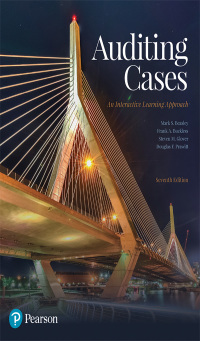It was like riding a tiger, not knowing how to get off without being eaten, according to
Question:
“It was like riding a tiger, not knowing how to get off without being eaten,” according to Satyam Computer Services Limited (Satyam) former Chairman, B. Ramalinga Raju, soon after massive fraud involving the company’s financial statements was revealed. For over five years, Raju was at the top of a massive fraud scheme orchestrated by senior executives at the Hyderabad, India information technology services company that falsely inflated its cash and cash-related balances by over $1 billion. In an amazing fraud scheme that went undetected by the company’s external auditors, senior executives directed the creation of over 6,000 false invoices and manufactured numerous false bank statements to create over $1 billion in fictitious cash balances and other interest bearing deposits.
Just before the fraud was revealed in January 2009, Satyam’s shares traded on the New York Stock Exchange (NYSE) at a price of $9.35. When trading resumed the next day, those shares dropped nearly 85 percent to close at $1.46. Institutional investors who owned those shares realized losses of over $450 million.
The audit of cash is often viewed as a fairly simple and straightforward set of procedures. Frequently, responsibility for verification of cash balances is assigned to newer, experienced members of the audit engagement team because of the relative low risk nature of cash related assertions and the objective versus subjective types of audit evidence typically examined. So, when the fraud was revealed, many were left wondering how such a massive fraud involving overstatement of cash balances went undetected by auditors for several years.
REQUIRED
[1] The Satyam auditors attempted to confirm both cash and accounts receivable balances with external parties. Which of the audit assertions for cash and accounts receivable would confirmations be most relevant?
[2] Research PCAOB auditing standards (which can be found on the PCAOB’s website – www.pcaob.org) related to the use of confirmations and document the specific requirements related to maintaining control of the confirmation process.
[a] Based on what you learn, provide an assessment of deficiencies in the confirmation approach Satyam’s auditors took related to cash and accounts receivable.
[b] Do auditing standards require the use of confirmations in the audits of cash balances and accounts receivable balances?
[3] Research the difference between American Depositary Shares and American Depositary Receipts. Then, visit the SEC’s website (www.sec.gov) to locate the final SEC rule Release No. 33-8879 issued on December 21, 2007 and research whether foreign issuers must file with the SEC financial statements in conformity with generally accepted accounting principles (GAAP).
[4] Research auditing standards and other guidance on effective internal control to answer the following questions: [c] What are IT general controls and what type(s) of IT general controls were compromised in the Satyam fraud? [d] What is meant by the term management override and how was that revealed in the Satyam fraud?
[5] Research the AICPA’s Code of Professional Conduct (which is available on the AICPA’s website – www.aicpa.org) to research what it means to be in a “network” of firms. How might the actions of one of the accounting firms in the network impact other members of the network?
[6] Research the PCAOB's website (www.pcaob.org) to learn about the PCAOB's inspection process. How often are firms inspected by the PCAOB and to what extent are the inspection findings available to the investing public?
[7] Research PCAOB auditing standards (which can be found on the PCAOB’s website – www.pcaob.org) related to the use of audit documentation and identify specific requirements related to deadlines for including audit documentation in the engagement workpapers, such as the documentation completion date. Also, identify requirements related to what must be documented on the workpaper, including the date of preparation of audit documentation and the identification of the preparers of the documentation. Based on your findings, provide your assessment of how PW Bangalore violated these requirements.
[8] Locate the PCAOB's Settled Disciplinary Order against the auditors of the Satyam financial statements, which can be found on the PCAOB's website under the link for "Enforcement" (see PCAOB Release No. 105-2011-002 dated April 5, 2011), and review the sanctions imposed on the audit firms within the PW India network. You will see that the PCAOB censured all five firms in the PW India network, even though three of those firms did not participate in the audit of Satyam’s financial statements. Discuss why the PCAOB charged all five firms rather than only charge PW Bangalore and Lovelock & Lewes?
PROFESSIONAL JUDGMENT QUESTIONS
It is recommended that you read the Professional Judgment Introduction found at the beginning of this book prior to responding to the following questions.
[9] One of the judgment shortcuts that can lead to bias in professional judgments is the "confirmation tendency." Briefly describe what is meant by confirmation tendency and where was that evident in the auditor's judgment process in the Satyam case?
[10] What can professionals do to overcome the confirmation tendency?
Step by Step Answer:

Auditing Cases An Interactive Learning Approach
ISBN: 9780134421827
7th Edition
Authors: Mark S Beasley, Frank A. Buckless, Steven M. Glover, Douglas F Prawitt





